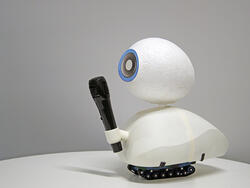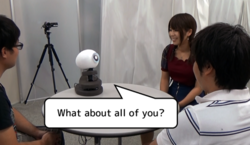
Ohshima, Naoki
| Affiliation | Institute for Research on Next-generation Semiconductor and Sensing Science (IRES²) |
|---|---|
| Concurrent post | Department of Computer Science and Engineering |
| Title | Lecturer |
| Fields of Research | Human-Robot Interaction, Human-Agent Interaction |
| Degree | Ph. D. (Toyohashi University of Tech.) |
| ohshima@eiiris Please append ".tut.ac.jp" to the end of the address above. |
|
| Laboratory website URL | https://www.sarl.jp/ |
| Researcher information URL(researchmap) | Researcher information |
Research
Currently, we are developing several communication robots that can involve in conversation with people using verbal and non-verbal means of communication. Through our research, we intend to construct a suitable robot architecture for achieving human-like multi-party conversation among more than two robots. In this study, we are constructing and evaluating the social interactions of robots that can participate in human communications. Therefore, our research findings will help to understand the daily communication mechanisms of humans.
Theme1:The Construction of Intermediary Agents as Coordinator of Remote Co-Dinning
Overview
“Remote co-dinning conversation” is developed as a preventative measure of social marginalization of elderlies living alone, along with the aim to enhance QoL of family living apart, which has high hopes for further development. Yet, “remote co-dinning” require video connections and continuous confirmation of the preparatory status of partners that may be a nuisance. This research aims to establish an intermediary agent that could give advice on dinning partner's physical and psychological preparation status for remote co-eating by accumulating and analyzing the daily life data through IoT sensors, so as to coordinate remote co-dinning. As a "mediator" for remote co-eating communication, the agents act as a direct messenger to deliver messages for remote families.
Keywords
Theme2:Design of a Speech Eliciting Robot that Intervenes in Brainstorming Sessions to Ensure Collaborative Group Work
Overview
For brainstorming to work effectively, a cooperative atmosphere in which all participants can exchange their ideas in a collaborative manner is essential. On such occasions, situations in which the topic of discussion moves on without some participants being able to share their comments or ideas must be obviated. In this research, we developed a speech eliciting robot (Neut) that ensures a cooperative brainstorming environment. Neut creates an atmosphere that makes it easier for participants who are often overlooked to express their ideas, by promoting cooperation from the other participants. Neut is a small robot that moves freely on a table (Figure 1) and approaches one or the other participant who has not yet had his/her speaking turn. After stopping in front of such a participant, it brings out a wireless microphone and prompts the participant to speak, while looking around restlessly to suggest to others that they give the participant a chance to speak.
From the behavior of Neut and the interaction among participants, we observed that it activates (1) motivation of participants to speak, (2) sensitivity to letting others speak, and (3) reconstruction of the Participation Framework. Further, the results of preliminary investigations (personality testing of participants) and experiments conducted to ascertain the effect of Neut on participants indicate that extroverts deferred speaking out of turn and introverts became active speakers, resulting in improved cooperation among participants.
Keywords
Theme3:Designing Conversation Robot Speaker-Designation Behaviors to Break Silences
Overview
In this study, we developed a robot that encourages multi-party human conversations and helps participants to deal with silences. We consider three types of robot behavior, i.e., (1) encouraging specific individuals to talk, (2) encouraging all participants to talk, and (3) designating no one, but promoting general discussion. We evaluate the robot that can repair silences using these speaker-designation behaviors based on conversations between it and three humans, analyzing these conversations in terms of the participants’ interaction and responses. We also discuss simple, practical methods of designing conversation enhance robot behaviors that enable them to break silences and keep conversations going.



